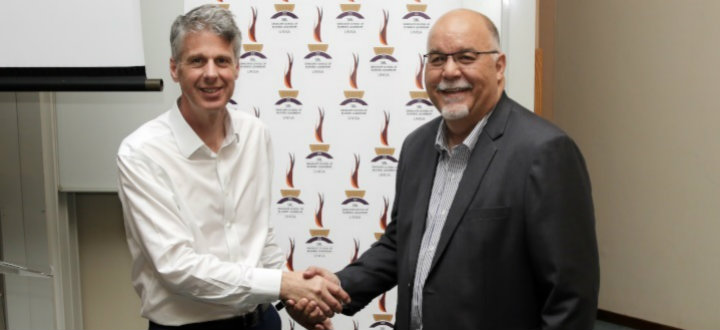

Left: Prof. Richard Whittington and SBL academic, Prof. Peet Venter
In a thought-provoking Masterclass lead by Prof. Richard Whittington from Oxford University he addressed the issue of an open strategy for organisations. The event was hosted by Unisa’s Graduate School of Business Leadership (SBL) in Midrand and forms part of SBL’s regular thought leadership events. Prof Whittington holds both a PhD from Manchester Business School as well as an MBA from Aston Business School amongst others. He is globally regarded as a leader in strategy studies and has had an illustrious career with extensive features in high profile journals, board membership and guest lecturing at a wide variety education institutions.
Prof Whittington coined the terms “big strategy” – which implies that the strategy of the organisation will have an impact on the community at large and “small strategy” – which only impacts on the organisation itself. “Open strategy gained force in this decade and has become more inclusive and transparent. People are much more aware of strategy and in most cases the boundaries of organisations have become more open to society.” says Prof. Wittington.
In his new book “Opening Strategy” he focuses on strategy and its development since the 1960s. Late in the previous century strategy was managed by Chief Executives and often kept under lock and key. In a modern environment organisations had to adapt to a more open strategy due to investor power demanding to know what the organisation’s strategy is, millennials who are well informed and regarded as valuable source of information and social media. An open strategy is also driven by the “business ecosystem” indicating that most organisations do not function in silos and are interdependent on other organisations for its existence.
By opening up the strategy, investors can make a more informed decision on their investments and will be able to ask the difficult questions regarding the future of an organisation. If management opens up the strategic planning process, a wider pool of ideas are put on the table and employees and other stakeholders will experience increased ownership of the future of the organisation. To regard a strategy as an open strategy top management must be transparent and inclusive. In recent years chief executives have gone as far as hosting a media conference to ensure that the organisation’s strategy is available to all relevant stakeholders. Trends indicate that organisations globally are moving towards openness however, this is not necessarily a uniform trend and the opposite is also true that some organisations are still operating like in the 1960s.
In order to determine if an open strategy will work for a specific organisation a few questions will need to be answered: How much do the company collaborate with external partners? How much does the organisation rely on informed investors? How important is millennials in the workforce? And, how complex and dynamic are the organisation?
During the lively discussion on “big strategy” Prof. Whittington specifically referred to big companies like Boeing and Facebook. With the recent crash of the Boeing 737 Max 8 in Addis Ababa, where 157 people were killed the strategy around the building and testing of this aeroplane has widely been scrutinised. It appears that the planning by Boeing was not to test the plane as rigorously as was previous practice. The crash (which was the second involving a Boeing 737 Max 8) has impacted on people across the globe. All of these aeroplanes have now been grounded which has an obvious impact on flight scheduling worldwide.
Boeing’s (as well as various other companies) strategy has an impact on society at large and can therefore be regarded as a “big strategy”. There are various measures that can be put in place to force such companies to open up their plans to all stakeholders, these include the hierarchy of the company (which is an internal measure), the market might change and competition may force an organisation to be more transparent, there are also regulatory bodies which can enforce more stringent rules to force an organisation to adapt their strategy and lastly, pressure from communities can also have a big impact on the adaption of a strategy.
Prof. Whittington concluded by saying: “strategy is equal to making a promise to all stakeholders e.g. with regards to the growth of an organisation. Open strategy can be good for business as well as society.”
Publish date: 2019-04-02 00:00:00.0
Contact the Marketing and Communication office: Ms Thami Kaunda at kaundn@unisa.ac.za
011 652 0339
Telephone: +27 11 652 0248 / +27 11 652 0291
Email: sbl@unisa.ac.za
Physical Address:
Cnr Janadel and Alexandra Avenues
Midrand, 1686
Gauteng, South Africa
Download map & directions (PDF)